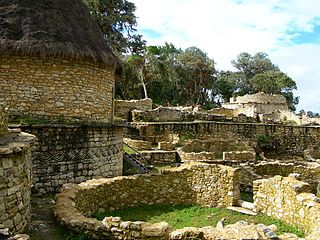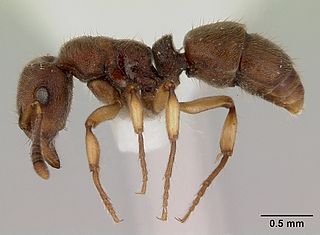
The Inca Empire, also known as the Incan Empire and the Inka Empire, was the largest empire in pre-Columbian America. Its political and administrative structure is considered by most scholars to have been the most developed in the Americas before Columbus' arrival. The administrative, political and military center of the empire was located in the city of Cusco. The Inca civilization arose from the Peruvian highlands sometime in the early 13th century. Its last stronghold was conquered by the Spanish in 1572.

Cusco, often spelled Cuzco, is a city in southeastern Peru, near the Urubamba Valley of the Andes mountain range. It is the capital of the Cusco Region and of the Cusco Province. In 2017, the city had a population of 428,450. Located on the eastern end of the Knot of Cuzco, its elevation is around 3,400 m (11,200 ft).

Machu Picchu is a 15th-century Inca citadel, located in the Eastern Cordillera of southern Peru, on a 2,430-metre (7,970 ft) mountain ridge. It is located in the Cusco Region, Urubamba Province, Machupicchu District, above the Sacred Valley, which is 80 kilometres (50 mi) northwest of Cuzco and through which the Urubamba River flows, cutting through the Cordillera and creating a canyon with a tropical mountain climate.

The Inca tern is a tern in the family Laridae. It is the only member of the genus Larosterna.

The Chachapoyas, also called the "Warriors of the Clouds", was a culture of the Andes living in the cloud forests of the Amazonas Region of present-day Peru. The Inca Empire conquered their civilization shortly before the Spanish conquest in the 16th century. At the time of the arrival of the conquistadors, the Chachapoyas were one of the many nations ruled by the Incas, although their incorporation had been difficult due to their constant resistance to Inca troops.

The Inca dove or Mexican dove is a small New World dove. Inca doves reach a length of 16.5–23 cm (6.5–9.1 in) and weigh 30–58 g (1.1–2.0 oz). They are slender, with a gray-brown body covered in feathers that resemble a scaled pattern. The tail is long and square and edged with white feathers that may flare out in flight. The underwings are reddish, like other ground doves, and upon takeoff, the wings produce a distinctive, quiet rattling noise.

The Incas were most notable for establishing the Inca Empire in pre-Columbian America, which was centered in what is now Peru from 1438 to 1533, and represented the height of the Inca civilization. The Inca state was known as the Kingdom of Cuzco before 1438. Over the course of the Inca Empire, the Inca used conquest and peaceful assimilation to incorporate the territory of modern-day Peru, followed by a large portion of western South America, into their empire, centered on the Andean mountain range. However, shortly after the Inca Civil War, the last Sapa Inca (emperor) of the Inca Empire was captured and killed on the orders of the conquistador Francisco Pizarro, marking the beginning of Spanish rule. The remnants of the empire retreated to the remote jungles of Vilcabamba and established the small Neo-Inca State, which was conquered by the Spanish in 1572.

Secret of the Incas is a 1954 adventure film starring Charlton Heston as adventurer Harry Steele, on the trail of an ancient Incan artifact. Shot on location at Machu Picchu in Peru, the film is often credited as the inspiration for Raiders of the Lost Ark. The supporting cast features Robert Young, Nicole Maurey and Thomas Mitchell, as well as a rare film appearance by Peruvian singer Yma Sumac.

Heteroponera brouni is a species of ant in the genus Heteroponera. It is endemic to the North Island of New Zealand, and the Three Kings Islands.
Heteroponera crozieri is a species of ant in the genus Heteroponera endemic to Australia. Described in 2011, the workers look similar to those of Heteroponera leae, although H. leae ants are more southerly distributed.

Heteroponera flava is a species of ant in the genus Heteroponera. Endemic to Brazil and Paraguay, it was described by Kempf in 1962.
Heteroponera inermis is a species of ant in the genus Heteroponera. Endemic to Brazil, it was described by Emery in 1894.
Heteroponera leae is a species of ant in the genus Heteroponera. It is endemic to Australia, and was described by Wheeler in 1923. It has a similar appearance to Heteroponera crozieri ants, although H. crozieri ants are more northerly distributed.
Heteroponera majeri is a species of ant in the genus Heteroponera. Endemic to Australia, it was recently described by Taylor in 2011. Its appearance is far different to other Heteroponera species that reside in Australia.

Heteroponera mayri is a species of ant in the genus Heteroponera. Endemic to Brazil and Paraguay, it was described by Kempf in 1962.

Heteroponera microps is a species of ant in the genus Heteroponera. Endemic to South America, it was described by Borgmeier in 1957.
Heteroponera monticola is a species of ant in the genus Heteroponera. Described by Kempf and Brown in 1970, Colonies are mainly inhabit high wet regions in Colombia, particularly in parts where ants of whatever kind are scarce.

Heteroponera panamensis is a species of ant in the genus Heteroponera. Endemic to Costa Rica and Panama, It was described by Forel in 1899.
Heteroponera robusta is a species of ant in the genus Heteroponera. Endemic to Brazil, it was described by Kempf in 1962.














